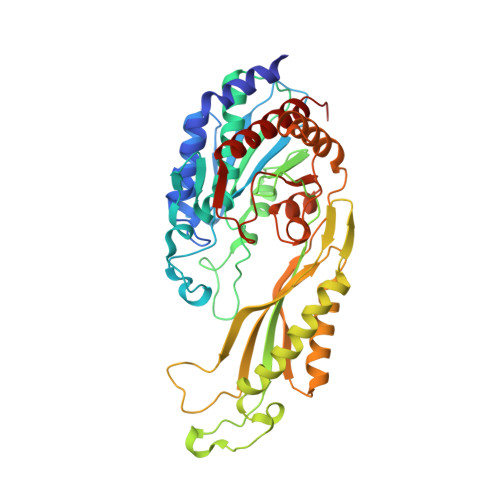Enzymatic hydrolysis by transition-metal-dependent nucleophilic aromatic substitution.
Kalyoncu, S., Heaner, D.P., Kurt, Z., Bethel, C.M., Ukachukwu, C.U., Chakravarthy, S., Spain, J.C., Lieberman, R.L.(2016) Nat Chem Biol 12: 1031-1036
- PubMed: 27694799
- DOI: https://doi.org/10.1038/nchembio.2191
- Primary Citation of Related Structures:
5K8M, 5K8N, 5K8O, 5K8P - PubMed Abstract:
Nitroaromatic compounds are typically toxic and resistant to degradation. Bradyrhizobium species strain JS329 metabolizes 5-nitroanthranilic acid (5NAA), which is a molecule secreted by Streptomyces scabies, the plant pathogen responsible for potato scab. The first biodegradation enzyme is 5NAA-aminohydrolase (5NAA-A), a metalloprotease family member that converts 5NAA to 5-nitrosalicylic acid. We characterized 5NAA-A biochemically and obtained snapshots of its mechanism. 5NAA-A, an octamer that can use several divalent transition metals for catalysis in vitro, employs a nucleophilic aromatic substitution mechanism. Unexpectedly, the metal in 5NAA-A is labile but is readily loaded in the presence of substrate. 5NAA-A is specific for 5NAA and cannot hydrolyze other tested derivatives, which are likewise poor inhibitors. The 5NAA-A structure and mechanism expand our understanding of the chemical ecology of an agriculturally important plant and pathogen, and will inform bioremediation and biocatalytic approaches to mitigate the environmental and ecological impact of nitroanilines and other challenging substrates.
Organizational Affiliation:
School of Chemistry & Biochemistry, Georgia Institute of Technology, Atlanta, GA.

















